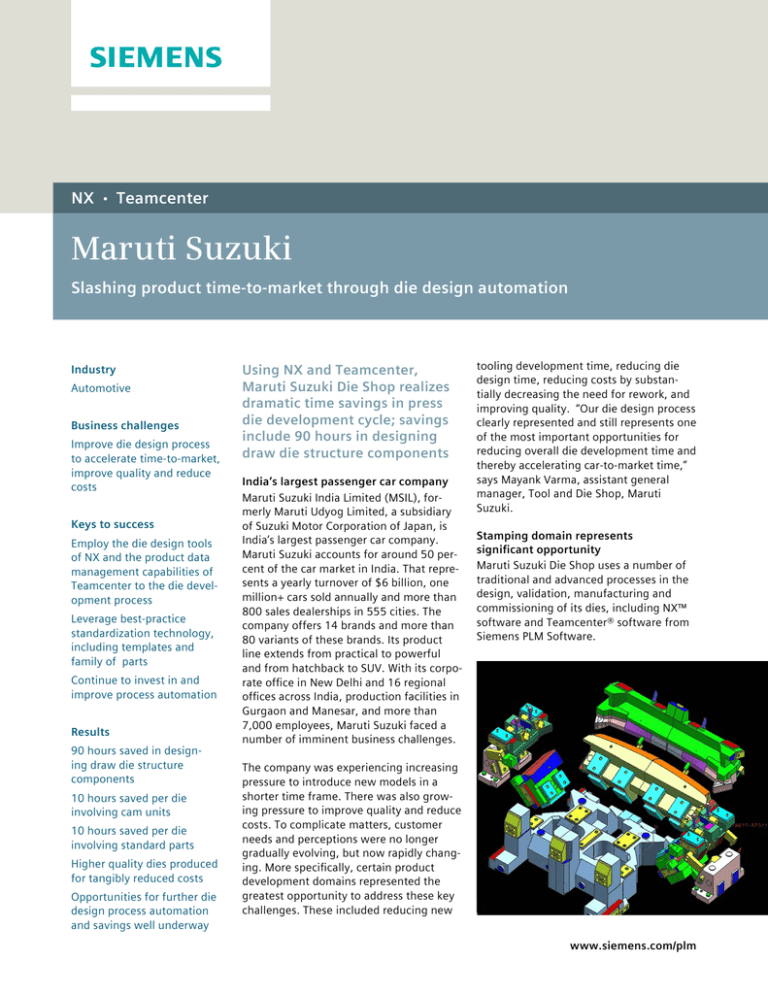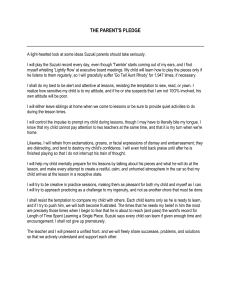
NX
•
Teamcenter
Maruti Suzuki
Slashing product time-to-market through die design automation
Industry
Automotive
Business challenges
Improve die design process
to accelerate time-to-market,
improve quality and reduce
costs
Keys to success
Employ the die design tools
of NX and the product data
management capabilities of
Teamcenter to the die development process
Leverage best-practice
standardization technology,
including templates and
family of parts
Continue to invest in and
improve process automation
Results
90 hours saved in designing draw die structure
components
10 hours saved per die
involving cam units
10 hours saved per die
involving standard parts
Higher quality dies produced
for tangibly reduced costs
Opportunities for further die
design process automation
and savings well underway
Using NX and Teamcenter,
Maruti Suzuki Die Shop realizes
dramatic time savings in press
die development cycle; savings
include 90 hours in designing
draw die structure components
India’s largest passenger car company
Maruti Suzuki India Limited (MSIL), formerly Maruti Udyog Limited, a subsidiary
of Suzuki Motor Corporation of Japan, is
India’s largest passenger car company.
Maruti Suzuki accounts for around 50 percent of the car market in India. That represents a yearly turnover of $6 billion, one
million+ cars sold annually and more than
800 sales dealerships in 555 cities. The
company offers 14 brands and more than
80 variants of these brands. Its product
line extends from practical to powerful
and from hatchback to SUV. With its corporate office in New Delhi and 16 regional
offices across India, production facilities in
Gurgaon and Manesar, and more than
7,000 employees, Maruti Suzuki faced a
number of imminent business challenges.
tooling development time, reducing die
design time, reducing costs by substantially decreasing the need for rework, and
improving quality. “Our die design process
clearly represented and still represents one
of the most important opportunities for
reducing overall die development time and
thereby accelerating car-to-market time,”
says Mayank Varma, assistant general
manager, Tool and Die Shop, Maruti
Suzuki.
Stamping domain represents
significant opportunity
Maruti Suzuki Die Shop uses a number of
traditional and advanced processes in the
design, validation, manufacturing and
commissioning of its dies, including NX™
software and Teamcenter® software from
Siemens PLM Software.
The company was experiencing increasing
pressure to introduce new models in a
shorter time frame. There was also growing pressure to improve quality and reduce
costs. To complicate matters, customer
needs and perceptions were no longer
gradually evolving, but now rapidly changing. More specifically, certain product
development domains represented the
greatest opportunity to address these key
challenges. These included reducing new
www.siemens.com/plm
“Our die design process
clearly represented and still
represents one of the most
important opportunities for
reducing overall die development time and thereby
accelerating car-to-market
time.”
Mayank Varma
Assistant General Manager
Tool and Die Shop
Maruti Suzuki
“We plan to slash at least
50 percent off the draw die
design cycle in the first year,
then 60 percent within the
next two to three years. We
have a vision and we feel
Siemens’ technology has
much to offer to make it
happen.”
Vidur Kaushik
Manager
Die Design, Die Shop
Maruti Suzuki
NX Die Structure Design applications
play key role in die design
standardization
Data is received from the Product Design
Group of Maruti Suzuki in NX format. Then
the die face, which includes addendum,
binder, draw bead, etc., is designed using
NX tools. The data is transferred to external computer-aided engineering (CAE)
software to do the validation of forming
simulation, e.g., addressing wrinkles in the
sheet metal folds, thinning, bend and trim
line issues, etc. “This is quite time-consuming; however, we have plans for improvements here,” notes Vidur Kaushik,
manager – Die Design, Die Shop, Maruti
Suzuki.
Once the simulation is done, the part is
tipped to the die position based on CAE
feedback and a layout is prepared via
NX 2D drafting by taking sections on the
parts. The die structures are then built.
Finally, it’s 2D and 3D machining, die
assembly and tryout, and off to
production.
The entire process is similar to that used
by other original equipment manufacturers (OEMs), except Maruti Suzuki Die Shop
has made significant process advancements in a number of areas, especially
relative to its die structures preparation
and building.
Templates yield 90 hours
saved for draw die structure
components
Using NX die design tools,
Maruti Suzuki Die Shop has
built many templates for its
die design stage. Here’s how it
works. The designer is presented with the template,
which shows the parameters
of the parts. The designer simply enters the new product
specifications to update the template to
the current design. The mating of the
standard parts is captured, so that any
change to a part reflects the position of
the standard parts as well. This substantially accelerates the speed with which die
structures are designed.
Maruti Suzuki Die Shop accomplished this
important time reduction through what it
describes as its “cloning concept” in which
the repeated structures in a design are
identified and treated as standard structure parts, creating the primitive or basic
template design. Mating points are
defined, mounting bodies created, map
files identified for positioning, etc., using
the template structure.
“It used to take approximately 180 hours
to build the components of the draw die
structure,” says Hardeep Singh, deputy
manager “Die Design, Die Shop, Maruti
Suzuki. “Using Siemens’ product lifecycle
management (PLM) tools, now it takes
about 90 hours – a 50 percent
improvement.”
Standardization delivers 10 hours
saved per die involving cam units
Similarly, Maruti Suzuki Die shop has
brought design standardization to its
cam unit creation. Instead of modeling
each cam one by one, the company has
created standard parts to automatically
build the cam unit. The company has
achieved a time saving of 10 hours per
die involving cam units, which translates
to potentially exponential savings depending on the project.
Solutions/Services
then 60 percent within the
next two to three years,” says
Vidur. “We have a vision and
we feel Siemens’ technology
has much to offer to make it
happen.”
NX
www.siemens.com/nx
Teamcenter
www.siemens.com/teamcenter
Customer’s primary business
Maruti Suzuki India Limited –
also called MSIL, formerly
Maruti Udyog Limited and a
subsidiary of Suzuki Motor
Corporation of Japan – is
India’s largest passenger car
company, accounting for
around 50 percent of its
domestic market segment.
Maruti Suzuki offers 13
brands, as well as more than
80 brand variants.
www.marutisuzuki.com
Customer location
New Delhi
India
“We plan to slash at least
one month in the first year
of the die development
cycle, then two months in
the coming years. Siemens’
solutions are integral to
making our vision a reality.”
Joy Lakra
GM – Body Engineering
Maruti Suzuki
Teamcenter manages family of parts
repository, resulting in another 10 hours
saved per die for standard parts
To date, Maruti Suzuki Die Shop has
75-80 family members in its standard
parts library, enabling the quick creation
of thousands of standard parts. The family
of parts library is managed by Siemens’
Teamcenter, which connects people
throughout the lifecycle with a single
source of product and process knowledge.
Maruti Suzuki Die Shop’s leveraging of a
family of parts repository has resulted in
additional important die development
process efficiencies – 10 hours saved per
die for standard parts.
“Using the die design tools of NX and collaboration capabilities of Teamcenter –
through cloning, cam standardization and
family of parts knowledge re-use – we’ve
realized significant time savings in the
development cycle,” says Santosh Kumar,
deputy manager – Die Design, Die Shop,
Maruti Suzuki. “Rework is dramatically
down. Quality is up. Costs per die have
decreased. Considering the number of
brands we market, including 80 plus variants, we are quite excited about our
opportunities for exceptional results from
a continuously improving stamping operation. We are definitely headed in a very
good direction.”
A vision for continuous die process
improvement
“We plan to slash at least 50 percent off
the draw die design cycle in the first year,
For example, Maruti Suzuki Die
Shop plans to move from the
visual editing tools of NX to its powerful
Knowledge Fusion capabilities, such as
Product Template Studio, which a number
of OEMs are already using.
Maruti Suzuki Die Shop’s goal is to do the
entire validation in a wholly integrated
environment that includes forming simulation, dynamic kinematics simulation, etc.
This would essentially eliminate the sometimes awkward and time-draining steps
involved in transferring data through the
initial graphics exchange specification
(IGES), standard for the exchange of product model data (STEP) or other formats.
As part of this new approach, the company is also evaluating the dynamic collision checking tools of Siemens to identify
and eliminate any interference that may
occur during die operations.
The bill of materials (BOM) represents
another item that Maruti Suzuki Die Shop
wants to leverage for time and cost savings. Currently the designers manually
enter each material item, including associated data, onto a spreadsheet – a very
time-consuming process. “The plan is to
generate the BOM automatically from the
3D models,” says Vikram Kathula, deputy
manager – Die Design, Die Shop, Maruti
Suzuki. “While this will require some process change on our part, it’s part of our
overarching plan. We have a vision for
continuous improvement across our entire
die design and related processes – one
that results in constant quality, time and
cost improvements for our customers,
partners and shareholders.”
Siemens Industry Software
Americas
+1 800 498 5351
Europe
+44 (0) 1276 702000
Asia-Pacific +852 2230 3333
www.siemens.com/plm
© 2011 Siemens Product Lifecycle Management Software Inc. All rights reserved. Siemens and the Siemens logo are
registered trademarks of Siemens AG. D-Cubed, Femap, Geolus, GO PLM, I-deas, Insight, JT, NX, Parasolid, Solid Edge,
Teamcenter, Tecnomatix and Velocity Series are trademarks or registered trademarks of Siemens Product Lifecycle
Management Software Inc. or its subsidiaries in the United States and in other countries. All other logos, trademarks,
registered trademarks or service marks used herein are the property of their respective holders.
Z5 23747 12/11 A





